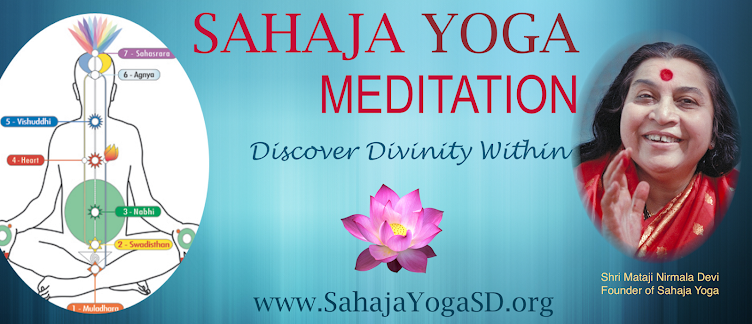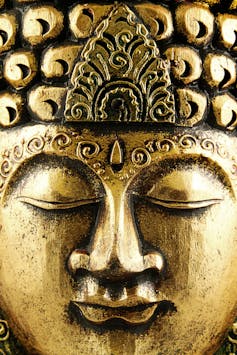|

Sahaja Yoga is an ancient form of meditation that brings about inner peace in a human being. One is able to achieve his 'yoga' or union with the divine energy, through the spontaneous awakening of the inner energy known as 'Kundalini'. This establishes an inner state, when one is at peace with himself and his surroundings, the state of pure witness and 'thoughtless awareness'. Sahaja Yoga was founded by Shri Mataji Nirmala Devi in 1970 and is widely practiced in over 120 nations today.
Tuesday, October 12, 2021
Fwd: Pay Attention To Your Liver. Here's Why.
Thursday, January 7, 2021
Meditation, mindfulness and mind-emptiness
Meditation, mindfulness and mind-emptiness

Ever been unable to sleep because you can’t switch off that stream of thoughts that seems to flow incessantly, mercilessly through your head?
When your mental noise distracts you from the task at hand, makes you forget why you walked into a room, or keeps you awake at night, you’re a victim of what is known in the East as “the monkey mind”. It is this thought stream that, according to Eastern tradition, is the source of much of our modern day stress and mental dysfunction.
So, what can you do about it?
Meditation
In the West, meditation has become a woolly term under which many different methods have found a home. Mindfulness is the latest, and certainly the most popular, addition.
Scientifically speaking, all approaches to meditation – be they relaxation, mindfulness, visualisation, mantras or otherwise – are associated with measurable but non-specific beneficial effects. So too are all stress management-style interventions even if they are not labelled as “meditation”.
So, does meditation have a specific effect or is it just another way to relax and de-stress? These are the questions that the scientific community continues to struggle with. Importantly, we can only answer this question if we have a clear understanding of what meditation is (or isn’t).
Our research shows that by defining meditation as “mental silence”, which is an evolution of the mindfulness concept, we can effectively answer the key scientific questions about meditation.
Mindfulness
Mindfulness essentially involves the passive observation of internal and external stimuli without mental reaction. It is most explicitly, but not exclusively, laid out in Buddhist meditation texts.

Mindfulness has become immensely popular for several reasons: its connection with Buddhism, which is very much in fashion; its secular style; and its suitability as an adjunct to many other mental health counselling strategies such as cognitive behavioural therapy.
There is no doubting that mindfulness has a useful role to play in preserving health and promoting wellness. But despite its hundreds of clinical trials, there is no consistent evidence of an effect specific to mindfulness itself.
In fact, the vast majority of evidence concerning mindfulness relates to clinical trials that do not control for placebo effects. This is something relatively few researchers seem to want to talk about, either because it’s too difficult or too politically incorrect.
Mental silence
Perhaps surprisingly, the oldest known definition of meditation predates both Buddhism and mindfulness by thousands of years. In the ancient Indian Mahabharata, the narrator states that a meditator is “… like a log, he does not think”. In other words, the earliest definitions describe the key defining feature of meditation as an experience of “mental silence”.
Many other explicit examples of this definition can be found in Eastern literature from virtually every historical period. Lao Tzu, for example, urged us to “Empty the mind of all thoughts” in the Tao Te Ching.
Yet Western definitions of meditation have consistently failed to acknowledge its significance. Perhaps this is because of the predominance of the Cartesian dictum “cogito ergo sum” (I think therefore I am) that has come to characterise not only Western philosophy but the psyche as well.
This might explain why for most people in the West, including the academics and researchers on whom we rely to generate our scientific knowledge, mental silence represents both an alien concept and an illogical experience.
Yet the results of more than a dozen years of scientific research here in Australia tells us that mental silence-orientated approaches to meditation are in fact both achievable and associated with specific benefits above and beyond those seen in non-mental silence approaches.
Take, for instance, my 2011 Meditation for Work Stress Study, involving 178 full-time Australian workers; it’s one of the most thoroughly designed randomised controlled trials of meditation in the scientific literature.

Participants were randomly allocated to one of three groups: either mental silence meditation, a relaxation-orientated intervention (non-mental silence) or a no-treatment control group. Their stress, depressive feelings and anxiety levels were measured using scientifically validated measures before and after the eight week program.
While people in both intervention groups improved, those in the mental silence group manifested significantly greater improvements than the relaxation group and the no-treatment group.
A randomised controlled trial of meditation for asthma sufferers mirrored these findings by comparing mental silence-orientated meditation to a stress management programme promoted by the state department of health. Not only were the psychological improvements significantly greater in the meditation group but there was also a reduction in the irritability of the airways.
Although further work needs to be done to identify the mechanisms, this change is likely the result of the modulation of chronic inflammation pathways, presumably through altered signalling from the brain.
Other larger surveys as well as smaller trials also demonstrate promising outcomes – all pointing toward the idea that mental silence is the key defining feature of meditation, responsible for effects specific to meditation.
Brain studies report some interesting findings. First, the experience is associated with a characteristic pattern of brain electrical activity – increased alpha-theta activity at the front and top of the brain along the midline. This is associated with reduced anxiety and improved attentional focus.
There was also a strong correlation between these objectively measured electrical changes and the subjective experience of the quality of the meditation experience.
Second, meditators exhibit reduced stress responses in the brain compared with non-meditators. This implies that the benefits are occurring at a neurophysiological level rather than being just a suppression of emotion or of its peripheral features.

Meditators, therefore, seem to be fundamentally modifying the way they generate negative emotions in response to the environment.
Reduced negative emotional reactions to stimuli should logically lead to reduced stress and an improved sense of well-being. But until studies where the brain changes are simultaneously measured alongside clinical changes, we can’t definitively state that these brain changes are the cause of the specific effects uncovered in our clinical studies.
Mind-emptiness
So how does this all fit together?
The mental silence paradigm is both complementary to and a progression of the mindfulness concept. While mindfulness involves the passive observation of stimuli with the aim of reducing mental reactions, mental silence involves progressing this experience to, and attaining, a state of no-mental-content-at-all, while remaining in full control of one’s faculties.
The original intention of mindfulness is as a method to facilitate the attainment of mental silence rather than being an ends in itself.
This shift in our understanding resolves many of the paradoxes that were hitherto insoluble – while at the same time offering consumers and clinicians a practically useful way to understand and benefit from meditation.
You can try the evidence-based techniques that we have evaluated for yourself by going to www.beyondthemind.com.
Ramesh Manocha is the author of Silence Your Mind, published by Hachette.![]()
Ramesh Manocha, Senior Lecturer, CADE Clinic, Department of Psychiatry, Sydney Medical School-Northern, University of Sydney
This article is republished from The Conversation under a Creative Commons license. Read the original article.
Monday, January 4, 2021
Fwd: Sahaja Yoga Meditation San Diego list: "A meditation goal for 2021?"
| Vikram Chandna (Co-Organizer) sent a message to the Sahaja Yoga Meditation San Diego mailing list |
New Year brings new hopes and noble desires. Do consider meditation as a goal for 2021 for yourself.
Sahaja Yoga Meditation is always free and founded in 1970 and has grown to be practiced in over 100 countries with help of volunteers like you who lead daily lives as engineers, doctors, accountants, teachers, students etc but at same have established in routine and habit of meditation and apply it to enrich their lives and that of others.
Sahaja Yoga grew with the untiring efforts of the founder Shri Mataji Nirmala Devi and who shared knowledge in simple motherly fashion. Following was shared with respect to New Year.
"Every year comes a new year, and the last year gets completed. For Sahaja Yogis every year is a new year because they stay in present. They stay neither in the future, nor in the past. Every moment for them is a new year, a new hope, a new wave."
Link to join:
When to join?
8:45 AM PST
Other time zones- use following to convert
https://www.thetimezoneconverter.com/
We recommend joining by laptop for better experience.
You can join up to 30 minutes before the start of the event if you have some queries or would like some 'one to one' help before the meditation session starts. If you need more help or a nearby mentor, please ask at the end of the session.

Look forward to seeing you. More session information attached for your reference.
For online meditation team
-Vikram
Fwd: [SY-USA] Fwd: New Research Article on Sahaja Yoga
https://journals.plos.org/plosone/article?id=10.1371/journal.pone.0237552
By the grace of Shri Mataji, the published results are extraordinarily good, we are talking about the largest published difference in gray matter between healthy groups of similar ages and circumstances. More details in the press release from the Communication Office of the University of La Laguna, attached to this message.
We take this opportunity to convey our congratulations and thanks to all participants, both scientists and volunteers who have made this study possible.



















